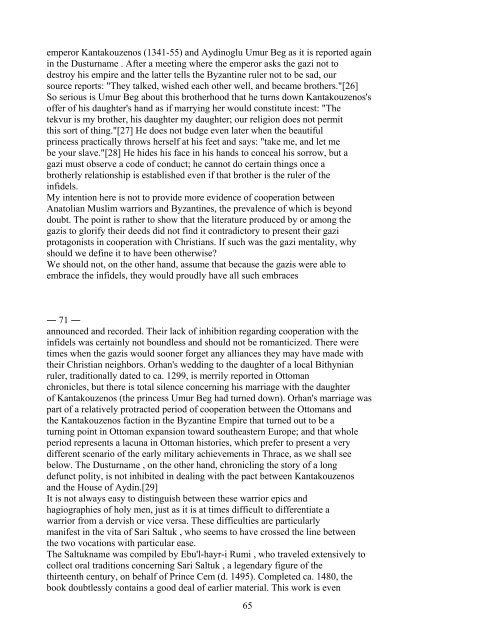Between Two Worlds Kafadar.pdf
Between Two Worlds Kafadar.pdf
Between Two Worlds Kafadar.pdf
Create successful ePaper yourself
Turn your PDF publications into a flip-book with our unique Google optimized e-Paper software.
emperor Kantakouzenos (1341-55) and Aydinoglu Umur Beg as it is reported again<br />
in the Dusturname . After a meeting where the emperor asks the gazi not to<br />
destroy his empire and the latter tells the Byzantine ruler not to be sad, our<br />
source reports: "They talked, wished each other well, and became brothers."[26]<br />
So serious is Umur Beg about this brotherhood that he turns down Kantakouzenos's<br />
offer of his daughter's hand as if marrying her would constitute incest: "The<br />
tekvur is my brother, his daughter my daughter; our religion does not permit<br />
this sort of thing."[27] He does not budge even later when the beautiful<br />
princess practically throws herself at his feet and says: "take me, and let me<br />
be your slave."[28] He hides his face in his hands to conceal his sorrow, but a<br />
gazi must observe a code of conduct; he cannot do certain things once a<br />
brotherly relationship is established even if that brother is the ruler of the<br />
infidels.<br />
My intention here is not to provide more evidence of cooperation between<br />
Anatolian Muslim warriors and Byzantines, the prevalence of which is beyond<br />
doubt. The point is rather to show that the literature produced by or among the<br />
gazis to glorify their deeds did not find it contradictory to present their gazi<br />
protagonists in cooperation with Christians. If such was the gazi mentality, why<br />
should we define it to have been otherwise?<br />
We should not, on the other hand, assume that because the gazis were able to<br />
embrace the infidels, they would proudly have all such embraces<br />
― 71 ―<br />
announced and recorded. Their lack of inhibition regarding cooperation with the<br />
infidels was certainly not boundless and should not be romanticized. There were<br />
times when the gazis would sooner forget any alliances they may have made with<br />
their Christian neighbors. Orhan's wedding to the daughter of a local Bithynian<br />
ruler, traditionally dated to ca. 1299, is merrily reported in Ottoman<br />
chronicles, but there is total silence concerning his marriage with the daughter<br />
of Kantakouzenos (the princess Umur Beg had turned down). Orhan's marriage was<br />
part of a relatively protracted period of cooperation between the Ottomans and<br />
the Kantakouzenos faction in the Byzantine Empire that turned out to be a<br />
turning point in Ottoman expansion toward southeastern Europe; and that whole<br />
period represents a lacuna in Ottoman histories, which prefer to present a very<br />
different scenario of the early military achievements in Thrace, as we shall see<br />
below. The Dusturname , on the other hand, chronicling the story of a long<br />
defunct polity, is not inhibited in dealing with the pact between Kantakouzenos<br />
and the House of Aydin.[29]<br />
It is not always easy to distinguish between these warrior epics and<br />
hagiographies of holy men, just as it is at times difficult to differentiate a<br />
warrior from a dervish or vice versa. These difficulties are particularly<br />
manifest in the vita of Sari Saltuk , who seems to have crossed the line between<br />
the two vocations with particular ease.<br />
The Saltukname was compiled by Ebu'l-hayr-i Rumi , who traveled extensively to<br />
collect oral traditions concerning Sari Saltuk , a legendary figure of the<br />
thirteenth century, on behalf of Prince Cem (d. 1495). Completed ca. 1480, the<br />
book doubtlessly contains a good deal of earlier material. This work is even<br />
65













